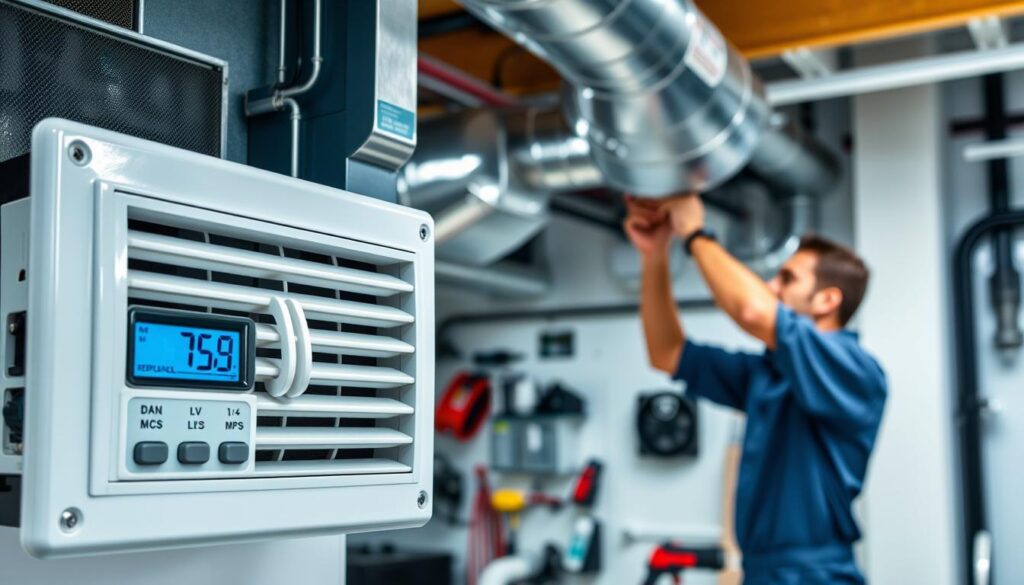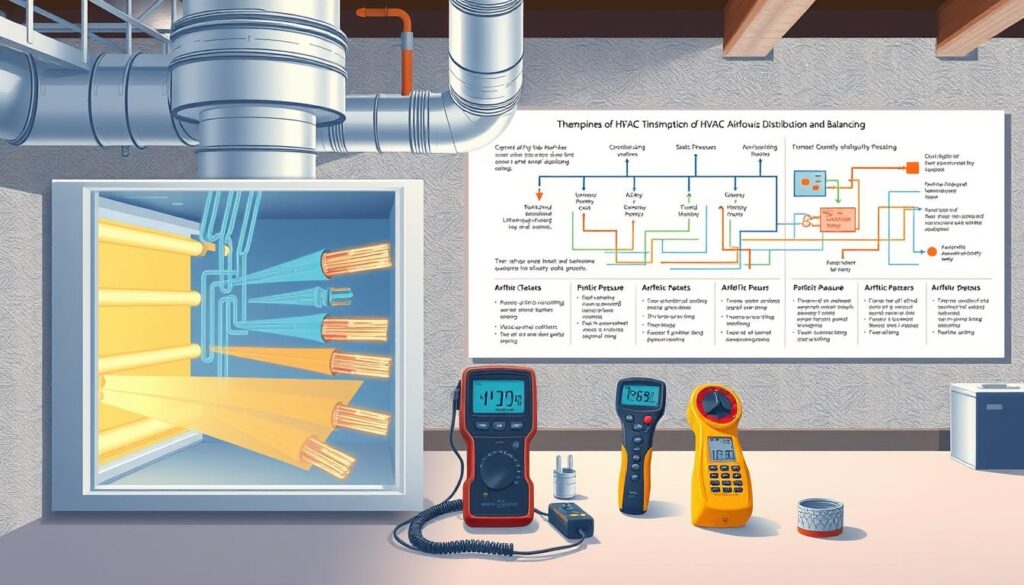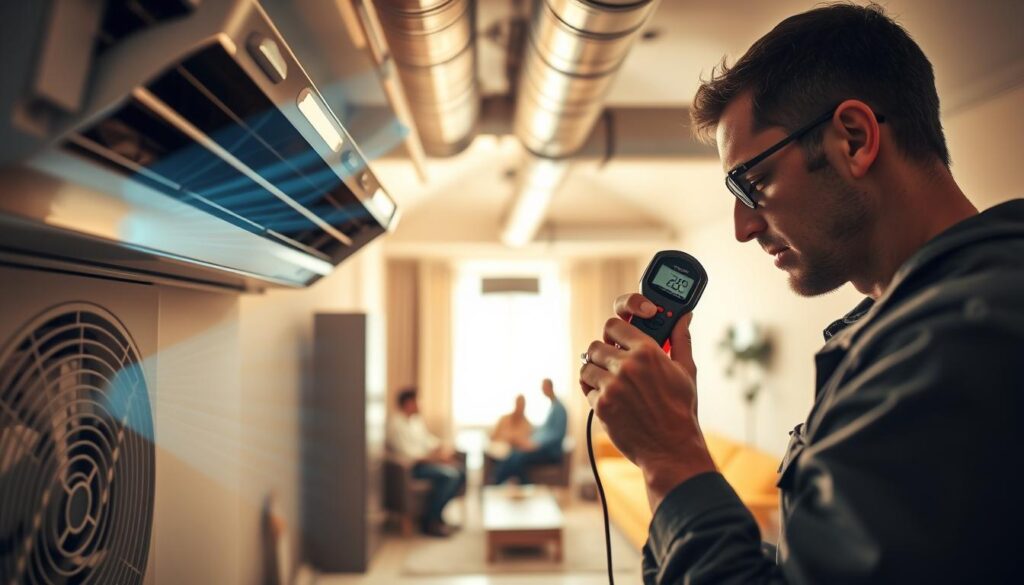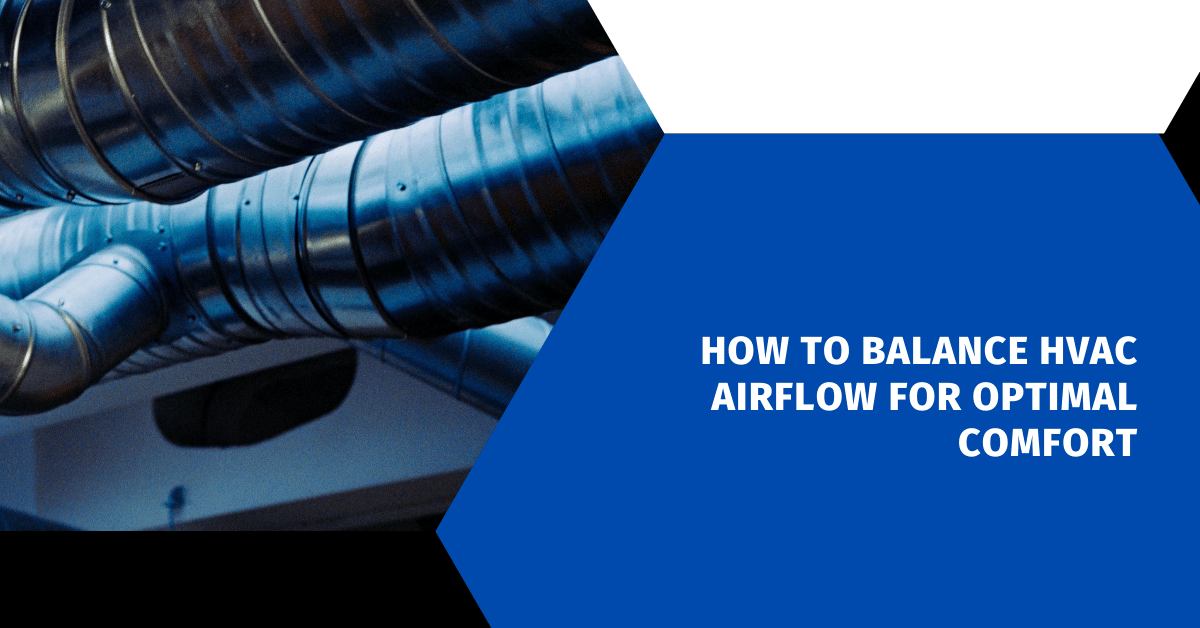Affiliate Disclosure
HVAC Guide Guys is a participant in the Amazon Services LLC Associates Program, an affiliate advertising program designed to provide a means for sites to earn advertising fees by advertising and linking to Amazon.
How to Balance HVAC Airflow for Optimal Comfort? Are you tired of hot and cold spots in your home? Want to find a way to balance indoor temperatures without spending a lot?

Balancing air distribution is more than a technical task. It’s the secret to a comfortable home. By learning to balance HVAC airflow, you make your heating and cooling system work better.
Every room should feel the same comfort. The right HVAC air balancing can fix temperature issues, save energy, and make your home more comfortable.
Key Takeaways
- Understand the critical role of balanced airflow in home comfort
- Learn how proper air distribution impacts energy efficiency
- Discover techniques to improve your HVAC system’s performance
- Recognize signs of unbalanced airflow in your home
- Explore both DIY and professional air balancing methods
Table of Contents
Understanding HVAC Air Balancing Basics
Your home’s comfort depends on a well-working HVAC system. The balance of your residential duct system is key to a great living space. Air balancing makes sure each room gets the right air for comfort.
Adjusting HVAC static pressure is vital for balance. Without proper air distribution, you might face uneven temperatures and higher energy bills. This also puts extra stress on your HVAC equipment.
What is Air Balancing and Why It Matters
Air balancing means making precise adjustments to your ductwork. Its main goals are:
- Ensuring even air distribution across all rooms
- Maximizing system efficiency
- Reducing energy consumption
- Extending HVAC equipment lifespan
Key Components of a Balanced HVAC System
Several important parts help with effective air balancing:
- Dampers: Control airflow in different zones of your home
- Properly sized ductwork
- Correctly positioned vents
- Balanced return and supply air
Benefits of Proper Air Distribution
A balanced HVAC system offers many benefits. You’ll see more even temperatures, fewer hot and cold spots, better air quality, and lower bills. A well-balanced system makes your HVAC work more efficiently.
Investing in professional air balancing can save you money and increase your home’s comfort in the long run.
Signs Your HVAC System Needs Air Balancing
Knowing when your HVAC system needs air balancing can prevent discomfort and high energy bills. Troubleshooting airflow problems early keeps your home comfortable and your system efficient.
Your home might be telling you it needs air balancing through several signs:
- Temperature variations of more than 2-3 degrees between rooms
- Noticeable hot and cold spots throughout your living space
- Uneven cooling in different areas of your home
- Unusual noises from vents during operation
Fixing uneven cooling begins with spotting these warning signs. Some specific symptoms include:
- Inconsistent Room Temperatures: One room feels like a freezer while another feels like an oven
- Weak Airflow: Certain vents produce minimal air despite being fully open
- High Energy Bills: Unexplained increases in monthly energy consumption
- Whistling or Rattling Sounds: Indicating potential airflow restrictions
Professional HVAC technicians can do detailed air balancing tests. They can diagnose and fix these issues, making sure your system works at its best.
Explore Our HVAC Shop
Looking for top-rated HVAC tools, parts, and accessories? Visit our shop and find the perfect solution for your needs.
Visit the ShopEssential Tools and Equipment for Air Balancing
Professional HVAC air balancing needs precision and the right tools. Knowing what equipment is needed helps improve air handler efficiency. It also ensures the zoning system works right. The right tools are key to getting the best airflow and system performance.
Measurement Instruments for Accurate Assessment
Choosing the right tools is crucial for air balancing. These tools help technicians find and fix HVAC system issues.
- Vane Anemometers: Measure air velocity and volume
- Digital Manometers: Check static pressure in ductwork
- Flow Hoods: Determine precise airflow at supply and return registers
- Infrared Thermometers: Detect temperature variations
Documentation Requirements for Comprehensive Analysis
Keeping detailed records is vital for HVAC system performance. Professionals keep detailed records to help with ongoing maintenance and efficiency goals.
| Document Type | Purpose |
|---|---|
| Duct Design Calculations | Verify system layout and airflow capacity |
| Equipment Specifications | Record manufacturer performance standards |
| Airflow Measurement Logs | Track system performance over time |
Safety Equipment for Professional Protection
Personal safety is crucial when doing air balancing. Technicians must wear the right protective gear to avoid injuries and work safely.
- Safety Glasses
- Dust Masks
- Protective Gloves
- Steel-Toed Boots
Proper tools and equipment are the foundation of effective HVAC air balancing and system optimization.
How to Balance HVAC Airflow: Step-by-Step Process
Learning to balance HVAC airflow is key to a comfortable home. It’s all about getting the air right where it needs to be. This means knowing how to adjust your HVAC system for the best airflow.
First, map out your home’s ductwork. Find the main air handler or furnace and follow the duct paths. This gives you a clear picture of how your HVAC system distributes air.
- Turn on your HVAC system’s fan at full speed
- Use an anemometer to measure airflow in each room
- Find rooms with uneven air distribution
- Adjust dampers in the ductwork
- Refine register openings for balanced airflow
Adjusting your ductwork takes patience. Check each room’s temperature and airflow, making small changes to dampers and vents. Precision is critical – even small tweaks can make a big difference.
Keep track of your changes. Log damper positions, vent settings, and room temperatures. This helps you understand your HVAC system better and makes future adjustments easier.
Pro tip: Perform balancing during typical weather conditions to get the most accurate measurements.
Getting perfect air balance might take a few tries. Be ready to make several adjustments over a few days. Your effort will pay off with more even temperatures and better comfort at home.
Explore Our HVAC Shop
Looking for top-rated HVAC tools, parts, and accessories? Visit our shop and find the perfect solution for your needs.
Visit the ShopUnderstanding Dampers and Vents in Air Distribution
Your home’s comfort depends on how dampers and vents work together. These parts are key to directing air flow in your home. They help make your living spaces cozy by controlling air circulation.
Dampers are like valves in your HVAC ductwork. They let you control air flow to different parts of your home. Adjusting them right can improve your home’s air balance.
Types of Dampers
Dampers come in different types for your HVAC system:
- Manual Dampers: Need a handle to adjust
- Motorized Dampers: Controlled by your HVAC system
- Balancing Dampers: Help balance air flow between rooms
Proper Vent Adjustment Techniques
Adjusting vents right means knowing your home’s air flow needs. You can boost comfort by:
- Checking each room’s temperature
- Finding out where it’s too hot or cold
- Changing vent openings to fix it
Seasonal Adjustment Considerations
Seasons change, and so does your home’s air flow needs. In summer, air flow might be different than in winter. Regularly check and adjust your dampers and vents to keep your home comfy all year.
Common Airflow Problems and Solutions

Dealing with airflow problems can be tough for homeowners. Knowing the common issues helps you find and fix cooling problems fast.
To fix uneven cooling, you need a step-by-step plan. If different rooms have different temperatures, it might mean there’s a ventilation problem. You’ll need to figure out what’s causing it.
- Blocked Air Vents: Stuff like furniture, curtains, or debris can block airflow, leading to uneven temperatures.
- Ductwork Leaks: If your ducts are damaged or not sealed well, it cuts down your system’s efficiency.
- Incorrect Damper Settings: If your dampers are not set right, it stops air from being distributed evenly.
- Dirty Air Filters: Clogged filters block airflow and make your system work less efficiently.
Signs you might have airflow problems include:
- Rooms that always feel warmer or cooler than others.
- Strange sounds like whistling or rattling from your vents.
- Higher energy bills even when your thermostat is set the same.
- Less comfort in your home overall.
Experts say it’s smart to have your HVAC system checked regularly to avoid these issues. Some problems you can fix yourself, but complex ones need a pro’s help.
Explore Our HVAC Shop
Looking for top-rated HVAC tools, parts, and accessories? Visit our shop and find the perfect solution for your needs.
Visit the ShopProfessional vs DIY Air Balancing Methods
Choosing between professional and DIY air balancing can be tough for homeowners. It depends on your skills, budget, and the HVAC system’s complexity.
When to Call a Professional
Professional HVAC technicians are key in many situations:
- Complex multi-zone heating and cooling systems
- Older homes with intricate ductwork
- Persistent temperature inconsistencies
- Need for proper zoning system calibration
Cost Considerations
Professional air balancing services cost around $100 per opening or vent. This might seem pricey, but the long-term benefits are worth it.
| Service Type | Average Cost | Complexity |
|---|---|---|
| Basic Air Balancing | $300 – $500 | Low |
| Advanced Zoning Calibration | $600 – $1,200 | High |
Certification Requirements
Professional HVAC technicians need specific certifications for air balancing. Look for those with:
- NATE (North American Technician Excellence) certification
- EPA refrigerant handling credentials
- State-specific HVAC licensing
“Investing in professional air balancing can significantly improve your home’s comfort and energy efficiency.” – HVAC Industry Expert
While DIY methods can work for simple systems, complex HVAC setups need professional help. This ensures the best performance and efficiency.
Maintaining Balanced Airflow Year-Round

Keeping your HVAC system in top shape needs regular care and smart maintenance. It’s important to balance your ductwork right to keep your system working well all year.
Your HVAC system needs regular upkeep to keep the air flowing smoothly. Here are some essential steps to follow:
- Do system checks every three months
- Swap out air filters every 1-3 months
- Check the hvac static pressure adjustment points
- Give air vents and registers a good clean
Seasonal changes affect your HVAC system a lot. In winter and summer, make sure to adjust your ductwork. This ensures the air flows evenly, no matter the temperature.
Experts say getting a full HVAC check once a year is a must. This thorough check can spot airflow problems early. Focus on these areas:
- Check if ductwork seals are tight
- Measure static pressure
- Make sure airflow is right
- Clean all system parts
Pro tip: Get a digital airflow tool to keep an eye on your system’s performance between checks.
Regular maintenance is the secret to keeping your HVAC system efficient and your home comfy for years.
Explore Our HVAC Shop
Looking for top-rated HVAC tools, parts, and accessories? Visit our shop and find the perfect solution for your needs.
Visit the ShopAdvanced Techniques for System Optimization
Getting the most out of your HVAC system is more than just regular upkeep. Advanced methods can boost air handler efficiency and enhance your home’s comfort. These techniques need careful planning and sometimes, the help of experts.
To make your air handler more efficient, try these advanced strategies:
- Install variable speed air handlers that adjust airflow dynamically
- Implement smart zoning systems for targeted temperature control
- Integrate advanced smart thermostat technologies
- Upgrade ductwork with precision-designed components
Calibrating your zoning system is key to better HVAC performance. This method divides your home into zones for different temperatures. With motorized dampers and multiple thermostats, your system becomes more efficient and responsive.
“Smart HVAC optimization is about creating intelligent, responsive comfort solutions that adapt to your unique living space.” – HVAC Engineering Professionals
Advanced optimization might include technical changes like:
- Adjusting fan speed configurations
- Replacing existing supply lines
- Installing specialized dampers
- Considering potential HVAC unit upgrades
While some steps need a pro, knowing these methods helps you make better choices for your home’s climate control.
Conclusion
Balancing air distribution in your HVAC system is key to a comfortable home. It’s not just a technical task. It’s about making your living space cozy and efficient. This guide shows you how to balance HVAC airflow for better temperature control and energy use.
Whether you do it yourself or hire a pro, the goal is to keep at it. Each room is different, so you need to measure and adjust carefully. This effort can really boost your comfort and save energy.
Keep in mind, HVAC air balancing is an ongoing task. Regular checks and tweaks are needed to keep your system running well. By following the tips here, you’ll make your home more comfortable and energy-smart, no matter the season.
Your dedication to air distribution can greatly improve your home’s comfort and energy use. Use what you’ve learned to make your living space more balanced and cozy.

